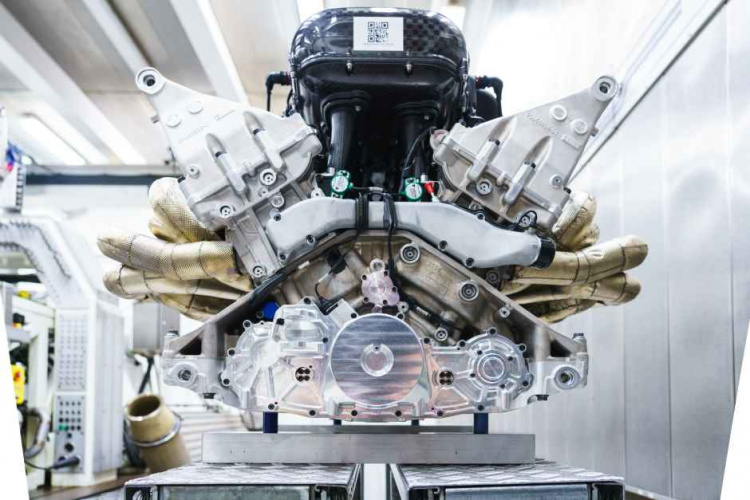
Even behind two hermetically sealed doors, three layers of bullet-proof glass, and several layers of acoustic damping, the scream of the chunk of precision-engineered metal strapped to a dynamometer deep inside the HQ of UK powertrain specialist Cosworth is frighteningly impressive. We’re reliably assured that were we standing next to it we wouldn’t be able to hear ourselves think.
This is the engine for the Aston Martin Valkyrie, the long-awaited £2.5m hypercar jointly developed with Red Bull Racing, which made its first public appearance at Silverstone during the British Grand Prix earlier this summer.
Developed by Cosworth in close collaboration with Valkyrie’s chief designer, Red Bull CTO Adrian Newey, this 6.5-litre V12 boasts the highest specific power of any normally aspirated production road engine in the world, producing 1,000bhp at 11,100rpm, and is key to the performance of what is claimed to be the fastest street-legal vehicle in the world.
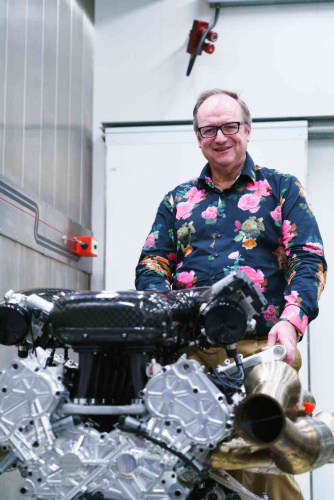
Cosworth, which celebrated its 60th anniversary in 2018, is the natural choice for such a project. Best known for its long association with motorsport – its legendary DFV (Double Four Valve) V8 engine remains the most successful prime mover in racing history – the Northampton firm has been expanding into other areas in recent years, and as MD Bruce Wood told The Engineer, the lucrative and growing market for high-end production engines is a logical outlet for its expertise.
“All the skills we’ve learned in motor racing are absolutely applicable in the road-car world,” he said, “because motor racing really is just about efficiency, whether it’s power-to-weight ratio, fuel consumption in F1; they’re all efficiency by another name.”
_________________________________________________________
Further reading
- Interview: delivering on Aston Martin’s bold vision for the future
- Breaking the mould and shaping the future at Aston Martin
- Motorsport seeks engineers to implement green tech
_________________________________________________________
Nevertheless, the Valkyrie engine pushes this dynamic to its limits. “It’s a combination of everything we’ve learned in the last 30 years both in terms of the engineering design and manufacturing excellence. This is not just some track-day special, this is Aston’s flagship car, and it’s a production vehicle.”
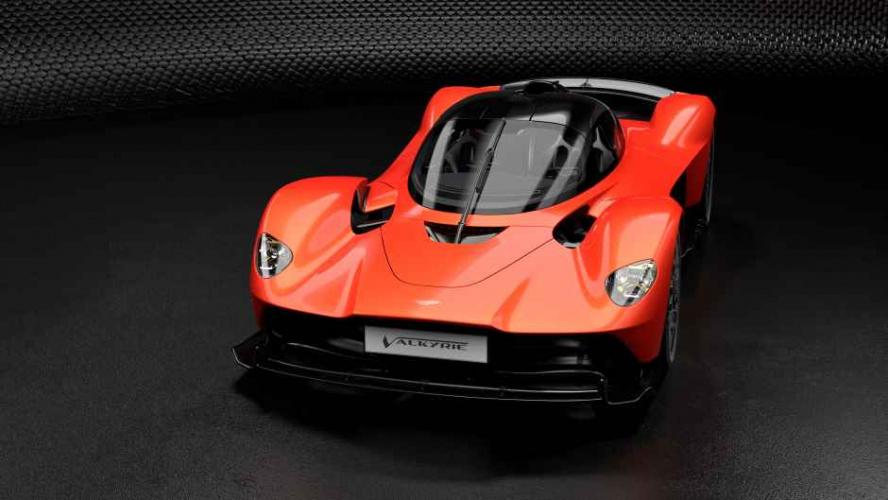
Indeed, while Aston may only be making 150 cars, the fact that it is technically a road car and has to meet the same regulations as other road cars is key. And balancing the demands for high power and low emissions without using a turbo charger was, said Wood, the core challenge of the project. “To make a 1,000hp, 6.5-litre engine, while a challenge in itself, is what we’ve done for our entire lives. The real challenge is to make a 1,000hp, 6.5-litre engine that meets Euro 6 emissions standards, because those two things, if not mutually exclusive, drive you in different directions.”
The key problem here is one of airflow: while high power requires lots of laminar flow into the engine, reduced emissions require turbulence. And with Adrian Newey adamant that the Valkyrie couldn’t simply use a turbocharger, Wood’s team had to come up with a different approach.
While Wood wouldn’t be drawn on precisely how his team pulled off this tricky balancing act, the story of how it got to this point is fascinating. And it began with the design and simulation of the combustion system. “It all comes down to the combustion system,” he explained. “You start with the combustion system and clothe it with the architecture of an engine.”
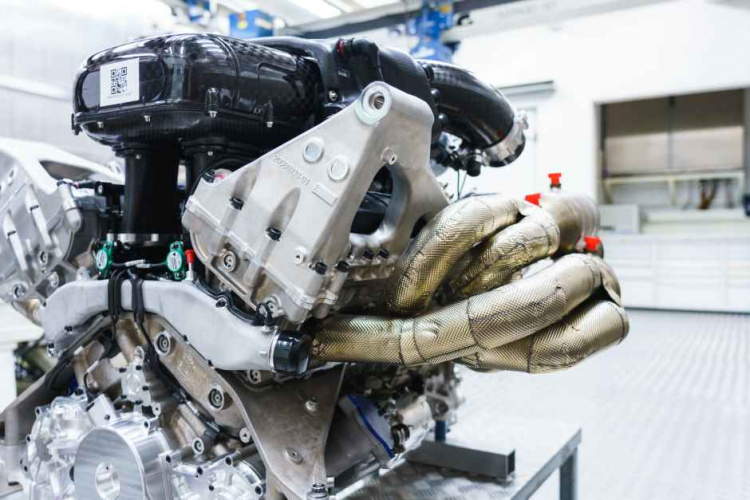
Within six weeks of kicking off the project, before any hardware had been developed, Wood’s team was confident that it could meet the emissions targets and get the airflow.
The next step was the development of a mule engine: a scaled-down three-cylinder version of the full engine. “We didn’t want to wait 12 months [the design time for the entire engine] to find out whether we were right about our combustion simulation, so we set out to make a quarter of an engine,” explained Wood. This three-cylinder model was up and running on the dynamometer within five months, and after just a couple of weeks of running, the team was confident that the final engine would deliver.
Beyond the combustion system, another major innovation in the design of the engine is the fact that it’s also a full structural element: remove the engine and there’s nothing connecting the front and rear wheels. Cosworth introduced structural engines to F1 in 1967, but it has never before featured on a production vehicle.
This means that the engine has had to be designed to withstand some pretty ferocious loads: “The forces are absolutely enormous,” said Wood, “which is why most people don’t do it – we’re quite used to designing engines as structural elements of a car but even for us this was very difficult.”
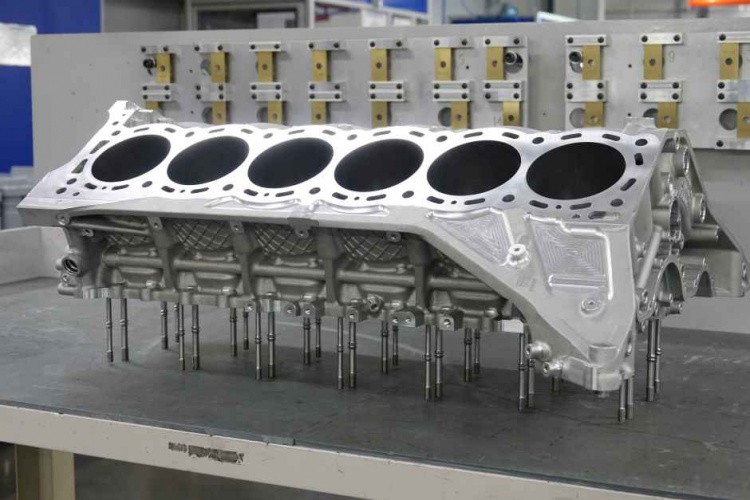
One of the reasons for this is that the car is a two-seater, and the engine mounts are therefore much further apart than in an F1 car. “To drive the weight out but to have the stiffness to take all of those loads and transmit them down to the only stiff bit of the engine was very, very difficult,” said Wood.
"You start with the combustion system and clothe it with the engine"
Another challenge has been integrating the Valkyrie engine with the car’s hybrid element, its 160hp electric motor, which was developed by Milton Keynes-based Integral Powertrain. Largely used to drive the car in reverse and to help with the gear shifting, this system – which is integrated into the gearbox – doesn’t come into physical contact with the engine. However, Wood said that a lot of the calibration strategy for the engine has revolved around the hybrid elements.
In terms of manufacturing, pretty much every part of the engine (from the cam covers, block and sump to the cranks, cylinder heads and pumps) were machined in house. The pistons were made on the firm’s own piston forge, while the cranks were painstakingly machined from a single billet of triple vacuum re-melted steel. Cosworth has been producing engines at a rate of about two per week since March 2019.
In the meantime, the engine continues to be put through its paces in the firm’s state-of-the-art Dynamometer facility.
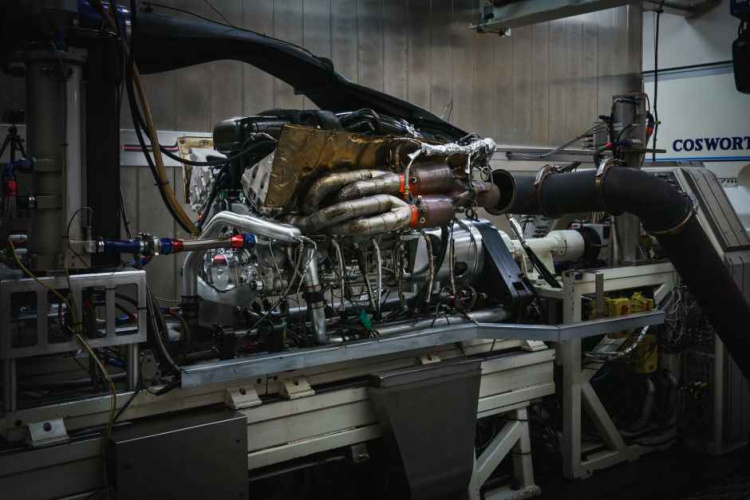
Originally built to test F1 engines, the facility – one of the most advanced of its kind in the UK – enables Cosworth’s technicians to replicate anything from the Nürburgring to a sedate trip to the supermarket, and to expose the engine to the full range of conditions that it will meet in the real world. “We can create anything from 10-degree air inlet to 45-degree air inlet, with anything from 0-100 per cent humidity,” explained lead dyno technician Liam Gorton.
While Valkyrie is going to keep Cosworth’s engineers busy for some time yet, the firm already has another supercar in its sights: the Gordon Murray T50, for which it will be making what’s expected to be the highest-revving engine ever used in a road car.
In the age of electrification, its perhaps surprising to see the V12 engine at the heart of any automotive firm’s plans for the future, but Wood is in no doubt that the market for high-end engines is growing and will form a significant part of the company’s future.
And while acknowledging the need to diversify – somewhat surprisingly, aerospace and marine projects now account for around 50 per cent of Cosworth’s revenues – he rejects the notion that the high-end space represents some rarefied final bastion for the internal combustion engine. “In 20 years, every vehicle will have some form of electrification, but I don’t subscribe to the view that that’s the death of the IC engine, and I don’t see anything on the horizon that will change that. The future is hybridisation. Electrification and the internal combustion engine have a happy life together for at least the next 10 to 15 years.”




Swiss geoengineering start-up targets methane removal
No mention whatsoever about the effect of increased methane levels/iron chloride in the ocean on the pH and chemical properties of the ocean - are we...